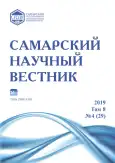Экологическое разнообразие некоторых ресурсных лекарственных грибов рода Pleurotus Новосибирской области
- Авторы: Власенко В.А.1, Асбаганов С.В.1, Власенко А.В.1
-
Учреждения:
- Центральный сибирский ботанический сад СО РАН
- Выпуск: Том 8, № 4 (2019)
- Страницы: 34-38
- Раздел: Общая биология
- URL: https://bakhtiniada.ru/2309-4370/article/view/34453
- DOI: https://doi.org/10.17816/snv201984106
- ID: 34453
Цитировать
Полный текст
Аннотация
Выявлены особенности субстратной специализации и распределения по типам местообитаний биотехнологически ценного ресурсного лекарственного вида грибов Pleurotus pulmonarius в Новосибирской области. Показано распределение вида по лиственным и хвойным породам деревьев, в связи с субстратной приуроченностью, распределение по типам местообитаний, сезонные особенности формирования плодоношений. Изученный вид приурочен преимущественно к лиственным породам деревьев, на хвойных он отмечен единственный раз на Abies sibirica. В целом, P. pulmonarius отмечен на 5 породах лиственных деревьев, из которых большинство образцов собрано на Betula pendula и Populus tremula, реже гриб встречается на Sorbus sibirica, Populus sp., Acer negundo, Tilia cordata, Salix alba. Чаще всего P. pulmonarius развивается в зональных мелколиственных и смешанных лесах, реже отмечается в поймах рек и прирусловых сообществах. Довольно часто гриб обнаруживается в искусственных посадках, где он является одним из наиболее часто встречающихся дереворазрушающих грибов антропогенных местообитаний. Плодоношение P. pulmonarius в Новосибирской области происходит с мая по октябрь, с пиком активности в конце лета – начале осени (август – сентябрь).
Полный текст
Открыть статью на сайте журналаОб авторах
Вячеслав Александрович Власенко
Центральный сибирский ботанический сад СО РАН
Автор, ответственный за переписку.
Email: vlasenkomyces@mail.ru
кандидат биологических наук, старший научный сотрудник лаборатории низших растений
Россия, НовосибирскСергей Валентинович Асбаганов
Центральный сибирский ботанический сад СО РАН
Email: cryonus@mail.ru
кандидат биологических наук, научный сотрудник лаборатории интродукции пищевых растений
Россия, НовосибирскАнастасия Владимировна Власенко
Центральный сибирский ботанический сад СО РАН
Email: anastasiamix81@mail.ru
кандидат биологических наук, старший научный сотрудник лаборатории низших растений
Россия, НовосибирскСписок литературы
- Vlasenko V.A. Substrate specialization of Wood-decay Aphyllophoroid fungi in the pine forest of the Right Riverside of the Ob Headwaters // Contempor. Prob. Ecol. 2009. Vol. 2, № 6. P. 620–624.
- Barros L., Baptista P., Correia D.M., Morais J.S., Ferreira I.C.F.R. Effects of conservation treatment and cooking on the chemical composition and antioxidant activity of Portuguese wild edible mushrooms // J. Agric. Food Chem. 2007. Vol. 55. P. 4781–4788.
- Ogbe A.O., Mgbojikwe L.O., Owoade A.A., Atawodi S.E., Abdu P.A. The effect of a wild mushroom (Ganoderma lucidum) supplementation as feed on the immune response of pullet chickens to Infectious Bursal Disease Vaccine // EJEAFChe. 2008. Vol. 7. P. 2844–2855.
- Lindequist U., Niedermeyer T.H.J., Jülich W.D. The pharmacological potential of mushrooms // Evid. Based. Complement. Alternat. Med. 2005. Vol. 2, № 3. P. 285–299.
- Wasser S.P. Medicinal mushroom science: history, current status, future trends, and unsolved problems // Int. J. Med. Mushr. 2010. Vol. 12. P. 1–16.
- Teplyakova T.V., Psurtseva N.V., Kosogova T.A., Mazurkova N.A., Khanin V.A., Vlasenko V.A. Antiviral activity of polyporoid mushrooms (higher basidiomycetes) from Altai Mountains (Russia) // Int. J. Med. Mushr. 2012. Vol. 14, № 1. P. 37–45.
- Gregori A., Svagelj M., Pohleven J. Cultivation techniques and medicinal properties of Pleurotus spp. Food Technol. Biotechnol. 2007. Vol. 45, № 3. P. 238–249.
- Isikhuemhen O.S., Nerud F., Vilgalys R. Cultivation studies on wild and hybrid strains of Pleurotus tuber-regium (Fr.) Sing. on wheat straw substrate // World J. Microbiol. Biotechnol. 2000. Vol. 16. P. 431–435.
- Stamets P. Growing gourmet and medicinal mushrooms. Ten Speed Press Berkeley USA. 2000. 554 p.
- Das N., Mukherjee M. Cultivation of Pleurotus ostreatus on weed plants // Bioresour. Technol. 2007. Vol. 98. P. 2723–2726.
- Çaglarırmak N. The nutrients of exotic mushrooms (Lentinula edodes and Pleurotus species) and an estimated approach to the volatile compounds // Food Chem. 2007. Vol. 105. P. 1188–1194.
- Vlasenko V.A., Vlasenko A.V. Antiviral activity of fungi of the Novosibirsk Region: Pleurotus ostreatus and P. pulmonarius (Review) // BIO Web Conf. 2018. Vol. 11. All-Russia Scientific-Practical Conference «Prospects of Development and Challenges of Modern Botany». P. 1–4. doi: 10.1051/bioconf/20181100044.
- Higgins D., Thompson J., Gibson T., Thompson J.D., Higgins D.G., Gibson T.J. CLUSTAL W: improving the sensitivity of progressive multiple sequence alignment through sequence weighting, position-specific gap penalties and weight matrix choice // Nucleic Acids Res. 1994. Vol. 22. P. 4673–4680.
- Kumar S., Stecher G., Li M., Knyaz C., Tamura K. MEGA X: Molecular Evolutionary Genetics Analysis across computing platforms // Molecular Biology and Evolution. 2018. Vol. 35. P. 1547–1549.
- Sneath P.H., Sokal R.R. Numerical Taxonomy. San Francisco: Freeman, 1973. 573 p.
- Tamura K., Nei M., Kumar S. Prospects for inferring very large phylogenies by using the neighbor-joining method // Proceedings of the National Academy of Sciences (USA). 2004. Vol. 101. P. 11030–11035.
- Tamura K., Kumar S. Evolutionary distance estimation under heterogeneous substitution pattern among lineages // Molecular Biol. Evolution. 2002. Vol. 19. P. 1727–1736.
- Vlasenko V.A. Ecological characteristics of Bracket Fungi in the forest steppe of Western Siberia // Contempor. Probl. Ecol. 2013. Vol. 6, № 4. P. 390–395.
Дополнительные файлы








